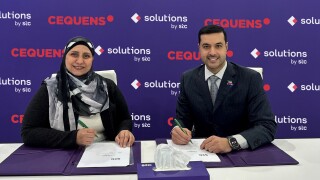
Highly scalable optical transport technologies are gaining importance to deal with increasingly complex needs for massive-scale data centre interconnection, including among webscale operators outside the traditional hyperscaler ecosystem. James Watt, head of the optical networks division at Nokia, talks of the latest optical innovations shaping the market.
In the world’s data centre market, big changes are afoot. As the sector grows and an increasing volume of workloads, applications and data move to the cloud and become more distributed, businesses and the webscale operators they depend on see an increasing need for massive scale and capacity to support this major transition.
The changes stepped up a few gears during the pandemic, with research suggesting that this situation sped up digitalisation and cloud migration by a number of years across a whole range of businesses worldwide. This has brought with it a demand for supporting infrastructure to handle the evolution.
Analyst firm Gartner predicted that spend on data-centre infrastructure would rise 6% to $200 billion in 2021 and continue to rebound over the next few years. In addition, surges in data centre activity have been forecast in North America and regions in Europe and Asia over the next five years as new projects are rolled out, including in locations away from the traditional key hotspots.
The Middle East is another area that shows promise, with hyperscalers building large data centres and clouds closer to regional markets in countries including Saudi Arabia and the UAE. Major submarine cable projects are also being rolled out between that region and other parts of the world.
Universal needs
As data centre infrastructure grows and expands to new areas alongside the emerging trend towards edge facilities, effective data centre interconnect (DCI) options are called for between providers’ growing number and spread of data centre sites – whether on a regional, international or global scale.
In today’s evolving market, this is not the domain of just the world’s largest hyperscale cloud providers. A wide range of tier-two players also want to emulate the way in which tier-one providers deploy and operate their networks, facilitating the ability to increase optical capacity while ensuring guaranteed quality of service and security, making optical networks more dynamic and optimising operational costs.
Such players range from cloud and colocation providers to carrier-neutral players, internet exchange operators and IP transit providers, and from wholesale to alternative and regional network operators.
James Watt, head of the optical networks division at Nokia, sees a growing “need for speed” in the market, as well as reduced latency. “The need for capacity has become universal,” he adds. “That was happening pre-Covid, but certainly Covid has accelerated some of those capacity needs.”
Characterising how capacity requirements have also altered from a structural perspective, Watt highlights that these have moved on from a relatively simple “A-to-B” type of arrangement in the past. “As needs have grown, that’s no longer sufficient,” he says. “Consumers need A to B to C, and tomorrow, D.”
He refers to the spread of “less simple” network topologies, transitioning from bespoke point-to-point data centre connections to more complex multi-site interconnections between regions, and metro-oriented connectivity with mesh and ring topologies.
From the end customer’s perspective, the outlook is towards more general connectivity in the form of a “virtual collection of data centres” that doesn’t require a bespoke arrangement to reach every new facility, says Watt. “The large challenge for everybody is how to contain the complexity that’s started to emerge and make the scaling-up process simple. There are a lot of moving parts, but that’s the core of it.”
Simpler scaling
The key to “taming” this growing complexity is the use of cutting-edge technologies that can enable effective scaling of optical networks, says Watt. He cites Nokia’s photonic service engines (PSEs) that combine coherent-optical technology using digital signal processing, along with dense wavelength division multiplexing (DWDM) – which enables network providers to scale their optical networks while maximising fibre capacity and reach.
For its part, Nokia has been rolling out an advanced fifth generation of PSEs, known as PSE-V, helping address optical transport over metro, long-haul and subsea distances. This includes successful recent trials of PSE-Vs ‘super-coherent’ optics that have enabled interconnection of data centres over long-haul distances using multiple wavelengths, each operating at 600Gbps.
Hitting this milestone illustrates the technology’s ability to boost optical capacity to underpin high-performing data centre interconnect services across and between regions.
The PSE-V Compact version, meanwhile, optimises capacity while minimising power consumption to connect data centres over short distances via pluggable 400G coherent optics.
In combination, these PSE-V options address different needs in terms of applications, form factors and platforms. The technologies are also aimed at facilitating transport of 400 and emerging 800 Gigabit Ethernet (GE) services over any distance and, importantly, reducing power consumption per bit – a key factor when it comes to today’s crucial goal of sustainability.
Boosting efficiency
Watt explains that new demands for data centre interconnect call for increasing efficiency, as well as reliability of connections between facilities. “The goal is to allow our customers to cost-effectively deploy the capacity their customers need in the places their customers need it. It’s not just about the capacity, but also having that capacity in the right place,” he says.
“With PSE-V, we’ve done a lot of work to find a number of different techniques to pack as much as we can onto a single wavelength. There will always be a need for more capacity, and that will require more innovation in the transponders to cram more bits onto a wavelength.
“We also make it easier and more power-efficient to connect data centres over short distances with PSE-V Compact, using pluggable 400G coherent optics that can be used in both IP routers and optical transport systems.”
Watt adds that there’s a need to make it easier for customers to adjust or build connectivity through automation, including plenty of scope for harnessing AI and machine learning. Those types of approach will allow customers to find even further opportunities to make the most of the investments they have made in fibre, physical data centres and technology, he says.
“We’re trying to take time and effort out of the equation, but also allow our customers to more easily monetise the investments they have made.”
Real-world networks
Players that have been seeking to harness some of these optical technologies to bolster their interconnect infrastructure include Netherlands-based data centre provider NorthC and Northern European communications provider GlobalConnect.
“Both NorthC and GlobalConnect are examples of regional operators that are seeing tremendous growth that’s being driven by their respective markets,” says Watt. These are the types of provider that have a great opportunity to use these technologies to scale, he adds.
Last September, Nokia, along with cybersecurity and cloud-networking firm Nomios, announced that they were implementing technology for NorthC to enable integrated IP and optical data centre interconnection. Now deployed, this involved the creation of a single virtual data centre by connecting 10 regional NorthC data centres in the Netherlands within a high-speed Region Connect Ring, making data applications, connections and cloud services available to customers located in any of these data centres, boosting bandwidth and reducing latency.
“The digital transformation of the Netherlands economy and the growing role of regions within it means there is a growing demand for local data centres and for high-speed, reliable connectivity between regions,” says Mario Hangjas, senior director of information technology at NorthC. “The Region Connect Ring allows customers to directly access network and cloud services that are not available in their own region.”
In a separate initiative early this year, Nokia and GlobalConnect demonstrated 600G transmission over a live long-haul link of the provider’s GO-COLOR network. This validated a planned backbone upgrade by GlobalConnect using PSE-Vs optics, involving scaling capacity over its existing ROADM network.
Commenting on GlobalConnect’s existing deployment of DWDM technology with Nokia, Jan Flemming Henriksen, head of transport network services at the company, says: “The latest DWDM technology maximises and future-proofs our own optical fibre capacity and provides high availability through a flexible meshed network.”
Evolution of interconnect
In a further link-up, Nokia is supplying optical-transport technology for the meshed network fabric of Netherlands-based neutral internet exchange NL-ix.
“This strategic partnership highlights NL-ix’s commitment to delivering even higher-capacity pan-European optical links between our PoPs in the Netherlands and abroad,” says Jan Paul Dekker, CTO at NL-ix. “The modularity of Nokia’s next-generation optical transport solutions enables us to adapt and respond quickly to market demand, and provide an even better quality-of-service and connectivity experiences for our customers.”
The ultimate aim, says Watt, is to make scaling up simple, despite the growing complexity – helping data centre customers get to where they want to be in terms of capacity and reach, but also keep things manageable whatever their size.
“There’s an evolution here that’s been coming, and that I think will continue and strengthen, from a point-to-point to a real mesh-networking approach, says Watt. “The pressure for capacity will continue… there’s also a continued need for scale, and that will bring with it a continuing growth in the richness of topologies.”
Learn more about how Nokia powers the evolution of optical data centre interconnect.
This article forms part of the special supplement Data Centre Interconnection. Click on the link to access the full supplement.
Register to attend a free webinar, 'Interconnection: why automation is critical for a successful cloud ecosystem', hosted by Capacity Media and Nokia.




